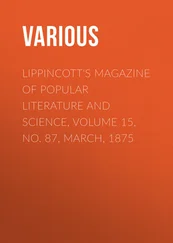Various - Appletons' Popular Science Monthly, March 1899
Здесь есть возможность читать онлайн «Various - Appletons' Popular Science Monthly, March 1899» — ознакомительный отрывок электронной книги совершенно бесплатно, а после прочтения отрывка купить полную версию. В некоторых случаях можно слушать аудио, скачать через торрент в формате fb2 и присутствует краткое содержание. Издательство: Иностранный паблик, Жанр: periodic, foreign_edu, на английском языке. Описание произведения, (предисловие) а так же отзывы посетителей доступны на портале библиотеки ЛибКат.
- Название:Appletons' Popular Science Monthly, March 1899
- Автор:
- Издательство:Иностранный паблик
- Жанр:
- Год:неизвестен
- ISBN:нет данных
- Рейтинг книги:3 / 5. Голосов: 1
-
Избранное:Добавить в избранное
- Отзывы:
-
Ваша оценка:
- 60
- 1
- 2
- 3
- 4
- 5
Appletons' Popular Science Monthly, March 1899: краткое содержание, описание и аннотация
Предлагаем к чтению аннотацию, описание, краткое содержание или предисловие (зависит от того, что написал сам автор книги «Appletons' Popular Science Monthly, March 1899»). Если вы не нашли необходимую информацию о книге — напишите в комментариях, мы постараемся отыскать её.
Appletons' Popular Science Monthly, March 1899 — читать онлайн ознакомительный отрывок
Ниже представлен текст книги, разбитый по страницам. Система сохранения места последней прочитанной страницы, позволяет с удобством читать онлайн бесплатно книгу «Appletons' Popular Science Monthly, March 1899», без необходимости каждый раз заново искать на чём Вы остановились. Поставьте закладку, и сможете в любой момент перейти на страницу, на которой закончили чтение.
Интервал:
Закладка:
Various
Appletons' Popular Science Monthly, March 1899 Volume LIV, No. 5, March 1899
THE EVOLUTION OF COLONIES
Perhaps there is no civilized institution to which, man has accommodated himself with so ill a grace as monogamy. Hardly a perversion of it has ever existed but may still be found. Polygamy is widely spread in the most advanced communities; temporary polyandrous ménages à trois are known to exist elsewhere than among the Nairs and Tibetans and ancient Britons; the matriarchate in one shape or another may be detected well outside the sixty peoples among whom Mr. Tylor has discovered it; and marriage by free choice is far from having superseded marriage by capture or by purchase. It is the less surprising that abnormal or ancient forms of the union should have been revived in colonies. In this relationship, as in most others, the colonist, like the sperm cell after its junction with the germ cell, sinks at once to a lower level, and the race has to begin life over again. The fall is inevitable. The earliest immigrants are all of them men. Everywhere finding indigenes in the newly settled country, they can usually count on the complaisance or the submissiveness of the tribesmen. Native women have a strange fascination for civilized men, even for those who have been intimate with the European aristocracies and have belonged to them. Adventurous Castins might find their account in a relationship that was in perfect keeping with the wild life they led. It is more strange that, enslaved by an appetite which sometimes rose to a collective if seldom to a personal passion, educated men, with a scientific or a public career flung open to them at their option, able men who have written the best books about the races they knew only too well, men of great position whose heroic deeds and winning manners made them adored by women of their own race, should have spoiled their prime, or inextricably entangled themselves, or wrecked their own roof-tree and incurred lifelong desertion by the wife of their youth. The bluest blood of Spain was not contaminated by an alliance with the Incas, but just ten years ago the direct line of an ancient English earldom was extinguished among the Kaffirs. The truth seems to be that while a woman will not as a rule accept a man who is her inferior in rank or refinement, a man easily contents himself for the time with almost any female. The Bantu woman and the Australian zubra are not alluring, but they have never lacked suitors. Colonial women shrink (or profess to shrink) from the Chinaman; all colors – black, brown, red, and yellow – seem to be alike to the undiscriminating male appetite. Yet it has its preferences. The high official who stands unmoved before the cloudy attractions of the Zulu, surrenders at discretion to the soft-voiced, dark-eyed, plump-limbed daughters of Maoriland. In the last case a perverse theory (of the future amalgamation of the races) may have been "the light that led astray"; it certainly was used to justify their acts to the consciences of the doers. Romance had its share: Browning's Waring (who was premier as well as poet) threw a poetic glamour over the miscegenation, as another minister found in the race the Ossianesque attributes of his own Highlanders. It sometimes, even now, rises into passion: the colonial schoolmaster who marries a native girl will declare that his is a love match. But the chief reason at all times was "the custom of the country." "It was the regular thing," remarked an old legislator, looking ruefully back on his past. Nor is it to be harshly censured. Corresponding to the Roman slave-concubinage which Cato Major did not disdain to practice, it repeated a stage in the history of the mother country when the invading Angles allied themselves (as anthropology abundantly proves) with the native Britons. While making a kind of atonement to the indigenes, it was a solatium to the pioneer colonists for a life of hardship and privation.
A higher grade was the concubinage of convictism, which was with women of the same race and was capable of rising into normal marriage. In the early days of New South Wales and Van Diemen's Land it seems to have been almost universal, and it lasted for many years. Not one in ten of the officials lived with his legally married wife. In the latter colony it was suppressed by the governor, who ordered them to marry the women by whom they had families. In the former, if Dr. Lang's account of his exertions is accepted, it was put down by the exposure of guilty parties. It was accompanied by other features of a low social state. The public and private sale of wives was not infrequent. The colonial equivalent for a wife, in the currency of those days, was sometimes four gallons of rum, or five pounds sterling and a gallon, or twenty sheep and a gallon; one woman was sold for fifty sheep.
Around gold and silver mining encampments nondescript relationships of a slightly higher order arise. They are with free women, though the women are apt to be of the same class as Bret Harte's Duchess of Poker Flat, answering to the Doll Tearsheets of hardly more civilized communities. They often issue in marriage. In mining townships, and even in colonial towns, professional men are to be found married to unpresentable women.
In colonies of regular foundation normal marriages are contracted under difficulties. Few women at first go out, the emigrants intending to return when they have made their fortune. Women have accordingly to be sent. In the seventeenth century a number of girls of good repute were persuaded to emigrate to Virginia, a subscription being raised to defray the cost. In the following century wives were sent to settlers in French Louisiana on the same plan. To French Canada women were dispatched by shiploads. They were selected (according to Parkman) as butchers choose cattle: the plumpest were preferred, because they could stand the winter best and would stay at home. In Virginia women were offered for sale to eager colonists, who willingly paid one hundred pounds of tobacco for one, or as much as one hundred and fifty pounds for a very pretty girl; a debt incurred for the purchase of a wife being considered a debt of honor. In the early days of Canterbury, New Zealand, when a consignment of servant girls arrived, young farmers would ride over the Port hills and carry them off, though in the style rather of young Lochinvar than of the Sabine rape. Settlers have often requested the agent general for the colony or the mayor of their native town to send them out a wife. Wives so easily acquired are apt to be lightly parted with, and within the last few years, in colonial villages, amicable exchanges have been effected – one woman going with her children to the house of another man, whose wife and children made a reciprocal migration. Facts such as these (which might readily be multiplied) show how easily so-called civilized man sloughs off the conventions of ages and sinks to a primitive level. They soon disappear, however, and social colonial conditions rapidly assimilate themselves to those of the mother country. In most young colonies marriage is universal and it is early. After a few days' acquaintance couples rashly engage themselves, in utter ignorance of one another's character or of their own, and a precipitate marriage follows, with such results as might be expected. Statistics show that the age of marriage on the part of women is steadily rising. In the early days of each colony a girl was deemed passée if she did not get married before she was twenty-one. In the decade that ended the first century of New South Wales the proportion of married women under that age fell from 28.17 to 23.55 per cent; in less prosperous Victoria, after only half a century, it fell from 21 to 17.4; in New Zealand there was a big drop from 29.4 to 19.7. The proportion of married women under twenty-five has also seriously declined. The decrease is noticeably correspondent with the increased number of young women who are gaining their own livelihood – largely as teachers and typewriters. On these lines the colonies are following the lead of the mother country. Long engagements, followed by late marriages with fewer children, take the place of short engagements with hasty marriages and larger families. Female celibacy is no longer dishonorable, and women are beginning to understand that they may be far happier single and self-supporting. The quality of marriage improves with its rarity. When an Australian M. A. marries an M. A., or the most brilliant of New Zealand professors marries one of his most distinguished students, we feel, as when a Dilke marries a Pattison, that the ideal of the union has been realized.
Читать дальшеИнтервал:
Закладка:
Похожие книги на «Appletons' Popular Science Monthly, March 1899»
Представляем Вашему вниманию похожие книги на «Appletons' Popular Science Monthly, March 1899» списком для выбора. Мы отобрали схожую по названию и смыслу литературу в надежде предоставить читателям больше вариантов отыскать новые, интересные, ещё непрочитанные произведения.
Обсуждение, отзывы о книге «Appletons' Popular Science Monthly, March 1899» и просто собственные мнения читателей. Оставьте ваши комментарии, напишите, что Вы думаете о произведении, его смысле или главных героях. Укажите что конкретно понравилось, а что нет, и почему Вы так считаете.












